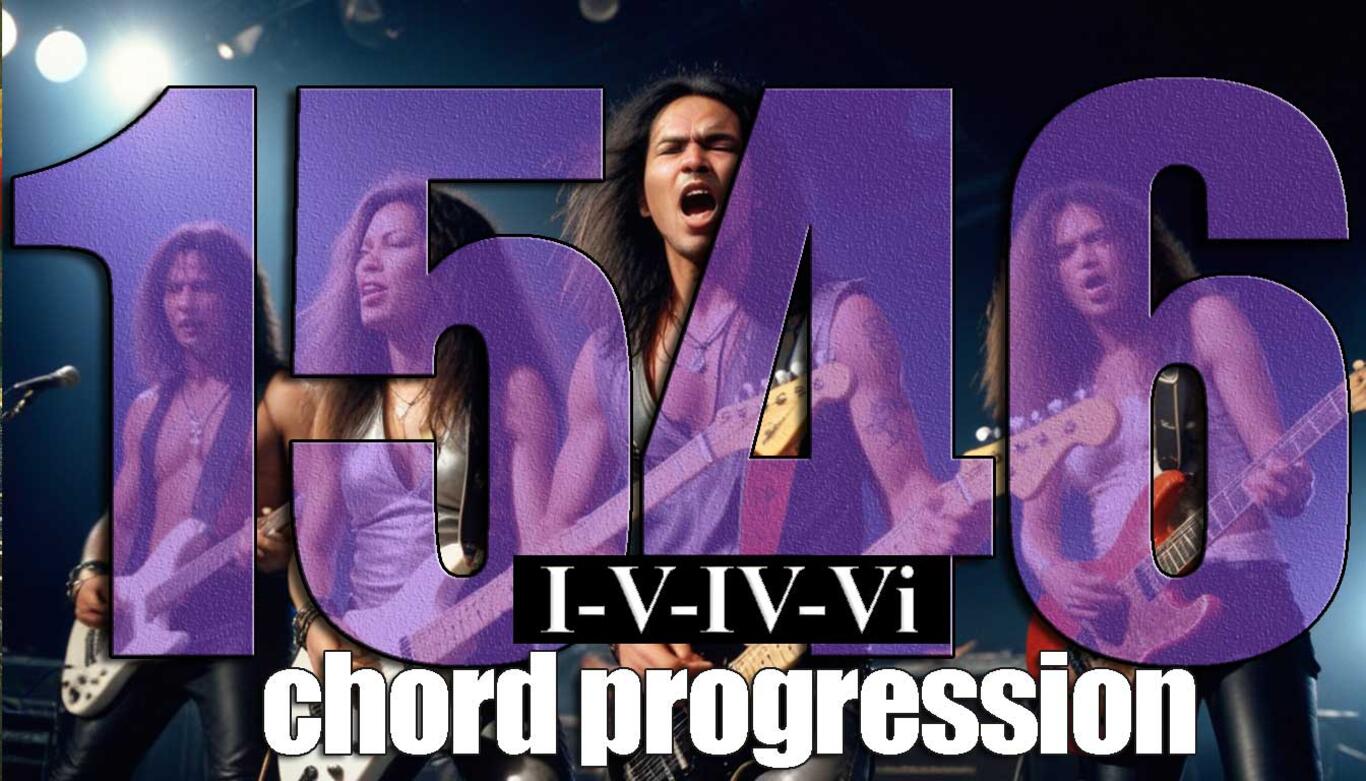The 1-5-4-6 (I-V-IV-vi) Chord Progression: What It Is, Why It Works, and Famous Pop Songs That Use It

Press Play to hear The 1-5-4-6 Chord Progression
The 1-5-4-6 chord progression is often called the Axis progression, after an Aussie band called the Axis Of Awesome who parodied the progression in a very popular YouTube video. They demonstrated the huge number of songs that rely on this progression. It's mind boggling really!
Ideal to loop over (enable the loop button above) to jam to, there are whole songs that do just that.
Famous Songs That Use the 1-5-4-6 Progression
Many famous songs across different genres have successfully used the 1-5-4-6 progression. Below are some iconic examples:1. “Let It Be” by The Beatles
- Key: C Major (C - G - F - Am)
- This Beatles classic uses the 1-5-4-6 progression throughout its verses and uses the closely related 1-6-4-5 chord-progression for the choruses. The familiar movement from the tonic (C) to the dominant (G) gives the song a strong, hymn-like feel, while the minor chord (Am) adds a touch of melancholy that perfectly complements the reflective lyrics.
2. “With or Without You” by U2
- Key: D Major (D - A - G - Bm)
- This song features the I-V-IV-vi progression prominently, contributing to its powerful and anthemic feel. The gradual build of the song, supported by the emotional range of this progression, made it one of U2’s most iconic tracks.
3. “She Will Be Loved” by Maroon 5
- Key: C Major (C - G - F - Am)
- The 1-5-4-6 progression drives this hit from Maroon 5, creating a perfect blend of emotional vulnerability and musical simplicity. The movement from C to G sets up tension, and the transition to Am and F brings in emotional depth.
4. “No Woman, No Cry” by Bob Marley
- Key: C Major (C - G - Am - F)
- This reggae classic prominently features the 1-5-4-6 progression. Its relaxed, flowing feel is reinforced by the repetition of this progression, which fits the soothing, laid-back vibe of the song.
5. “Take Me Home, Country Roads” by John Denver
- Key: A Major (A - E - D - F#m)
- The combination of major and minor chords gives this folk/country classic its bittersweet feeling. The vi chord (F#m) brings a sense of nostalgia that resonates with the song's lyrics about longing for home.
6. “Can You Feel the Love Tonight” by Elton John
- Key: B♭ Major (B♭ - F - E♭ - Gm)
- Featured in Disney's The Lion King, this song uses the I-V-IV-vi progression to build a rich, romantic, and heartwarming atmosphere.
7. “Someone Like You” by Adele
- Key: A Major (A - E - D - F#m)
- The emotional ballad makes full use of the vi chord (F#m) to heighten the sense of loss and vulnerability. The combination of this with the familiar major chords creates a powerful emotional journey.
What Is the 1-5-4-6 Progression?
The 1-5-4-6 chord progression is also known as the I-V-IV-vi progression in Roman Numeral notation and is one of the most popular and widely used harmonic sequences in Western popular music. It is beloved for its emotional resonance, versatility, and universal appeal across genres. From classic rock to modern pop, this progression has stood the test of time, playing a foundational role in countless songs.
The numbers 1, 5, 4, and 6 refer to the scale degrees (or chords) built on the corresponding notes of a diatonic scale, typically in the major key. For instance, in the key of C major, the chords would be:
- 1 (I) = C major
- 5 (V) = G major
- 4 (IV) = F major
- 6 (vi) = A minor
In this case, "I" refers to the tonic chord, "V" refers to the dominant, "IV" refers to the subdominant, and "vi" refers to the relative minor chord of the tonic.
Chord Breakdown in a Few Major Keys
Here’s how the 1-5-4-6 progression looks in several major keys:
- Key of C Major: C (I) - G (V) - F (IV) - Am (vi)
- Key of G Major: G (I) - D (V) - C (IV) - Em (vi)
- Key of D Major: D (I) - A (V) - G (IV) - Bm (vi)
- Key of A Major: A (I) - E (V) - D (IV) - F#m (vi)
Why Does the 1-5-4-6 Progression Work?
The 1-5-4-6 progression works so well for several reasons, most notably due to its combination of familiarity, tension and resolution, and emotional impact. Here's a breakdown of why it sounds so satisfying by David Bennet who has a superb YouTube Channel I can recommend
We start on the one and then the progression initially moves away as far away as you can go from the root chord to the fifth chord, which introduces tension and motion. But now we need to go somewhere. If we wanted to wrap things up, we'd go back to one but that would be a bit boring, so we go to the six chord which offers a different type of resolution, though not a full resolution so we now introduce a bit more tension by going to the four chord. The four chord, much like the five chord doesn't feel resolved so we head back to the one.
Conclusion
The 1-5-4-6 chord progression remains one of the most versatile and popular progressions in Western music due to its simplicity, emotional range, and familiarity. From its foundational role in pop, rock, reggae, and country, to its use in modern ballads and anthems, this progression has stood the test of time. Its ability to move between joy, tension, and melancholy makes it a favorite among songwriters, and its appeal to listeners ensures that it will continue to shape the sound of popular music for years to come. Whether it's being used to deliver a heartfelt ballad or an upbeat anthem, the 1-5-4-6 progression is an essential tool in any musician or songwriter’s toolbox.
NEXT >> the 1 6 4 5 chord progression





